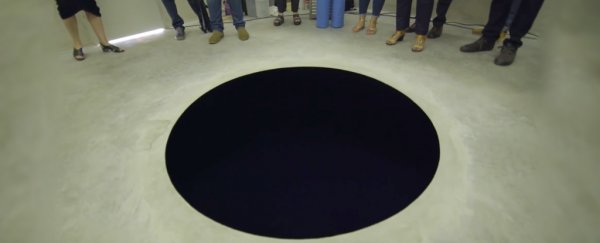Not everybody 'gets' art, but one man's failure to comprehend the artwork in front of him was so extreme he literally fell through a black void into limbo.
A museum visitor scrutinising Anish Kapoor's Descent Into Limbo at the Serralves Museum in Portugal let curiosity get the better of him when inspecting the ultra-black optical illusion, and unwittingly fell into it.
The accident – which makes the artwork's name seem eerily prescient – happened last Monday, and ultimately required hospital treatment for the 60-year-old Italian tourist who took the fall (but is thankfully okay).
It's not surprising medical attention was needed given what Descent Into Limbo really is.
The installation may resemble a flat, 2D black hole painted on the concrete floor of a room, but it's actually a deep three-dimensional 'void' that descends 2.5 metres (over 8 ft) into the ground.
The illusion is made possible by an extremely dark pigment that coats the internal walls of the hole so they reflect hardly any light, making them almost impossible to see with the human eye.
If the concept sounds familiar, you may have heard of Vantablack, the so-called blackest material on Earth, invented by British researchers in 2014 and capable of absorbing 99.96 percent of ultraviolet, visible, and infrared light.
This remarkable trick – achieved by millions of tiny carbon nanotubes – makes things sprayed with Vantablack seem truly unreal, and similar intensities of blackness that have evolved in the natural world are no less mesmerising.
As it turns out, Kapoor – a British sculptor famous for large, perspective-challenging installations – acquired exclusive rights to use Vantablack in art back in 2016, something which ruffled feathers elsewhere in the art world.
However, Descent Into Limbo is actually a 1992 work, pre-dating the invention of Vantablack by decades.
So unless the installation has been updated since Kapoor purchased his exclusive artistic licence, it's not actual Vantablack making Descent Into Limbo so compellingly descent-worthy.
In any case, it's clear Kapoor has long been attracted to the ultra-dark aesthetic, using his own pigments to evoke a similar effect long before Vantablack was a thing.
Or, as the Serralves Museum's exhibition of Kapoor's work describes it: "The sculpture is an expression of Kapoor's interests in the formal and metaphoric play between light and darkness, inside and outside, the contained and the infinite."
Yes. Just don't stray too close.
